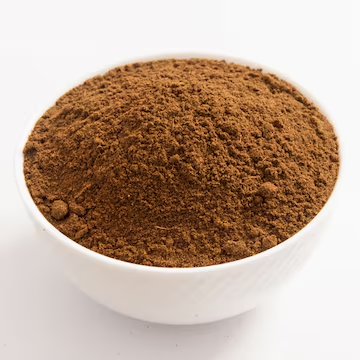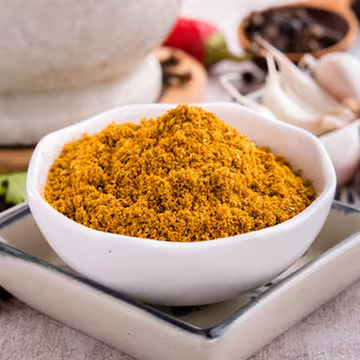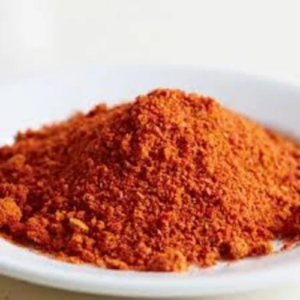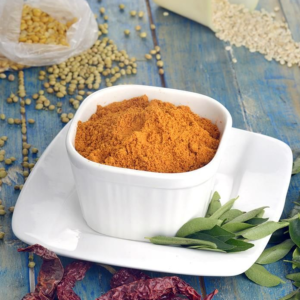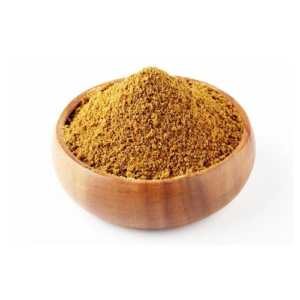Description
Key Ingredients in Regular Garam Masala:
The ingredients in garam masala can vary slightly depending on the region and the specific recipe, but the most common spices in a regular garam masala blend include:
- Cumin: Earthy, warm, and slightly nutty, cumin provides a deep base flavor that is essential to garam masala.
- Coriander: Coriander has a mild, citrusy, and slightly sweet flavor that complements the earthiness of cumin.
- Cardamom: Both green and black cardamom may be used. Green cardamom is aromatic, sweet, and floral, while black cardamom has a more smoky, bold flavor.
- Cinnamon: Sweet and warm, cinnamon adds a hint of spiciness and a slightly sweet fragrance.
- Cloves: Cloves contribute a sharp, sweet-spicy flavor, offering an intense, pungent note to the blend.
- Black Pepper: The addition of black pepper gives garam masala a mild heat and a sharp, pungent taste.
- Bay Leaves: Bay leaves are sometimes included, offering a subtle, herbal, and slightly bitter taste that enhances the complexity of the blend.
- Nutmeg: Nutmeg adds a touch of sweetness and warmth, balancing the stronger flavors of the spices.
- Mace: Mace, the outer covering of nutmeg, is sometimes included for its aromatic, slightly sweet flavor.
- Fennel Seeds: Some garam masala blends include fennel seeds for a mild, sweet, and slightly licorice-like note.
The specific proportions of each ingredient can vary, and some variations may also include star anise, dried ginger, turmeric, or mustard seeds, depending on regional preferences.
Flavor Profile:
- Warm and Aromatic: Garam masala is known for its deep, warming flavors, with the combination of cinnamon, cloves, cardamom, and cumin providing a comforting, aromatic experience.
- Mildly Sweet: The presence of cinnamon, nutmeg, and fennel lends a slight sweetness, which balances out the sharper, more pungent spices like black pepper and cloves.
- Earthy and Complex: The spices like cumin and coriander give garam masala an earthy, grounding base, while the cardamom, cinnamon, and cloves add layers of complexity.
- Pungent: The black pepper and cloves contribute a mildly spicy, pungent kick, but garam masala is typically not very hot in terms of heat intensity—its “heat” comes from the richness of its spices.
Common Uses:
Regular garam masala is an essential spice mix in Indian and South Asian cooking, and it can be used in many different ways:
- Curries and Stews: Garam masala is often added toward the end of cooking to enhance the flavor of curries, dals (lentil dishes), and meat or vegetable stews. It can be used in both vegetarian and non-vegetarian dishes.
- Rice Dishes: Garam masala can be added to rice dishes like biryani, pulao, or jeera rice to give them a fragrant, spiced flavor. It’s often included when tempering the rice or in the final stages of cooking.
- Marinades: Garam masala is commonly used in marinades for meats, fish, or paneer (Indian cottage cheese), providing flavor before grilling or frying.
- Vegetables: A sprinkle of garam masala can elevate simple vegetable dishes, such as aloo gobi (potato and cauliflower curry), baingan bharta (smoked eggplant), or any mixed vegetable curry.
- Soup and Lentils: The spice blend can be added to lentil soups or dals to give them a warm, spicy flavor.
- Sautéing and Templing: It is often added to hot oil or ghee (clarified butter) at the start of cooking to release the essential oils and fragrances of the spices. This process, called tadka, is a foundational technique in many Indian dishes.
- Snacks and Sweets: In some regions, garam masala is also used to season roasted nuts or to enhance savory snacks. Occasionally, it may be used in small amounts in certain Indian sweets for a balance of flavors.
Health Benefits (Claimed):
While garam masala is typically consumed in small quantities, the spices used in the blend have been associated with a variety of health benefits, including:
- Digestive Health: Many of the spices, such as cumin, coriander, and fennel, are traditionally believed to support digestion by promoting the production of digestive enzymes, easing bloating, and helping with indigestion.
- Anti-inflammatory: Several spices in garam masala, particularly turmeric (if included), cinnamon, and cloves, are known for their anti-inflammatory properties, which may help reduce inflammation in the body.
- Rich in Antioxidants: Spices like cloves, cinnamon, and cardamom are rich in antioxidants, which help protect the body from oxidative damage caused by free radicals.
- Boosts Immunity: The blend of spices in garam masala is often believed to have immune-boosting properties, with certain ingredients like garlic, ginger, and cumin providing antibacterial and antiviral benefits.
- Metabolism: Some of the spices, such as black pepper and ginger, are believed to help boost metabolism, making garam masala a popular addition to weight management diets.
Regional Variations:
While regular garam masala is a staple across much of North India, different regions may have their own versions or variations of the spice mix:
- Punjabi Garam Masala: Known for being particularly aromatic and spiced with strong elements like cardamom and cloves.
- Kolkata Garam Masala: In this version, more sweet spices, such as nutmeg and mace, may be used to create a slightly sweeter, less pungent version of garam masala.
- Mughlai Garam Masala: Associated with Mughal cuisine, this blend might be richer, sometimes including dried rose petals, saffron, or other luxurious spices.
- South Indian Garam Masala: In South India, the garam masala may be more peppery and contain ingredients like curry leaves and coconut, giving it a distinct regional twist.
Conclusion:
Garam Masala (Regular) is an essential, versatile spice blend that adds warmth, depth, and complexity to countless South Asian dishes. It provides a rich, aromatic base with a perfect balance of earthy, sweet, and pungent flavors, making it a go-to seasoning for curries, rice dishes, vegetables, and meats. With its myriad spices, garam masala not only enhances the taste of your food but also offers various health benefits, from supporting digestion to boosting immunity. Whether you’re a home cook or a seasoned chef, garam masala is an indispensable pantry staple for creating authentic and flavorful dishes.


